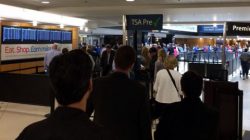Not quite everyone, but it’s still “everyone” in the sense that the TSA is planning to let ordinary people use the PreCheck lanes — including those who have not experienced the same background check and other pre-screening measures that are currently required to be PreCheck-eligible.
One of the best ways to use PreCheck right now is to get Global Entry, an expedited process operated by Customs and Border Patrol to let people scan their fingerprints at a kiosk and go on their way. People have reported getting off an international flight and reaching the airport curb in less than 10 minutes. It also gives you a number that you can put in your reservation information that makes you eligible to use PreCheck on domestic flights. Because I don’t have to take off my shoes, empty my liquids, or remove my belt and coat, I usually get through security in less than 5 minutes. There also isn’t much of a line because so few people are eligible (about 2%).
According to Executive Travel, the TSA has plans to use its existing passenger information database to sort the other 98% of passengers into low-, medium-, and high-risk categories. Those passengers who pose a lower security threat may be shuttled through the PreCheck lines. Executive Travel says the percentage of all air passengers going through PreCheck could climb from 2% to 25% by the end of the year.
The new policy is going to be in place by the end of October.
I’m not sure how I feel about this. On one hand, I think TSA is a farce. Passing all these extra people through PreCheck isn’t going to make me feel that air travel is any more dangerous. On the other hand, I went through the effort of getting Global Entry precisely because I wanted the benefits of the short or non-existent lines for PreCheck (most of my travel is domestic, so I find the immigration benefits to be minimal).
I worry that with all these extra people, PreCheck is going to have lines just as bad as the rest of airport security. It will still be less degrading, but it will take just as long.
This news makes better sense of the TSA’s recent decision to increase the number of airports with PreCheck lanes from 40 to 100 by the end of the year. If only 2% of passengers are using the checkpoints, it is difficult to defend expanding the program. Most of the large airports have already implemented it. If making more people eligible is necessary to create more PreCheck lanes at more airports — and hopefully give them longer hours for early and late-departing flights — then that’s a good thing.
Those individuals being selected as “low-risk” will probably still be chosen at random, meaning that Global Entry remains useful if you want to all but guarantee PreCheck access for every trip.



